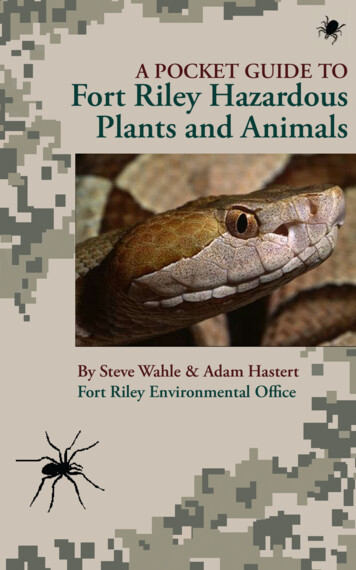
Transcription
A POCKET GUIDE TOFort Riley HazardousPlants and AnimalsBy Steve Wahle & Adam HastertFort Riley Environmental Officei
Table of ContentsIntroduction . 2PlantsPoision Ivy . 4Stinging Nettle . 6Edible vs. Non-Edible Plants . 8Poision Hemlock . 8Nuttall’s Death Camas . 10FungiPoisionous vs. Non-Poisonous Mushrooms . 11Insects & ArachnidsChiggers . 13Ticks . 15Mosquitoes . 22Wasps . 24Velvet Ants . 29Bees . 30Brown Recluse Spider . 38Black Widow Spider . 40Scorpion . 42Beneficial Spiders . 43ii
MammalsBats . 44Rats & Mice . 46Other Mammals . 48Venomous SnakesCopperhead . 50Timber Rattlesnake . 52Prairie Rattlesnake . 54Massasauga . 56Venomous vs. No-Venomous Snakes . 58Snake Bite . 60Information . 62Glossary . 63Acknowledgements . 68Velvet Ant Steven N. Severinghaus1
IntroductionThe Fort Riley Military Installation is thehome of the Big Red One. This 101,000acre military training facility is locatedbetween Junction City and Manhattanin the Flint Hills of northeastern Kansas.It is one of the largest publicly ownedtallgrass prairie tracts in the UnitedStates. Not only does the installationoffer state of the art training for ourcountry’s Soldiers, it also provides someof the best outdoor recreational opportunities in the state. Anytime spent outdoors, either for training or recreation, should bespent cautiously as many animals and plants in the area could bepotentially hazardous.The purpose of this pocket guide is to help you identify andunderstand those hazardous plants and animals found on FortRiley and the surrounding area. The species mentioned in thisguide comprise an extremely interesting and beneficial segment ofour flora and fauna. Although hazardous, they should be avoided,not destroyed. These organisms have developed complex and oftenunique defense mechanisms to help them survive. We shouldremember that in some cases, their survival depends upon ourattitudes and actions.2
Fort Riley Military InstallationThere are very specific requirements for public access to FortRiley. Information concerning access and outdoor recreationalopportunities is available by calling (785) 239-6211 during regularbusiness hours.3
Poison IvyToxicodendron radicansPoison ivy is a native, woody species that grows in threeforms in Kansas: an erect shrub that can grow up to six feet tall, ashort shrub that spreads by underground stems or rhizomes, anda climbing woody vine with aerial roots. The shrub form can befound statewide in a variety of habitats while the vine form is morecommon in the eastern half of the state. On all forms, the leavesare alternate and compound with three leaflets that are two to sixinches long and pointed, having edges either smooth or coarselytoothed. Small yellowish-green flowers bloom in May-June inloosely branched clusters. The fruit and seeds are round and ivoryin color and are consumed by a wide variety of birds. Poison ivycontains oily and resinous compounds, known as urushiols, thatcause dermatitis in most people within a few hours of contact. Theoil is not volatile, and despite many claims, one cannot be affectedmerely by being near the plant. Plants retain the urushiols afterdrying, and smoke from the burning plants may be dangerousif inhaled. Animals are seldom susceptible although their furcan transmit urushiols to humans. For those individuals that aresensitive to urushiol, itching starts and small blisters form, usuallywithin a few hours after exposure. Depending on how strong theexposure was and/or how sensitive the person is, it may developinto an inflamed, swollen rash with open, weeping sores thatpersists for up to two weeks.Over-the-counter anti-itch medications may be effectivefor some, but individuals with severe cases should seek medicalattention. If you have been exposed, wash quickly with soap andwater. Washing will aid in breaking down the oils, reducing thechance or severity of a reaction. The best treatment is prevention.Become familiar with the appearance of the plant and try toidentify it before exposure. Remember “Leaves of three, let it be.”4
5
Stinging NettleUrtica dioicaStinging nettles are native to and very abundant in Kansas.Usually found growing near or around water, this herbaceousperennial can grow up to 10 feet tall (usually three to five feet)during the summer and dies down to the ground during thewinter. The soft green leaves are one to six inches long, withstrongly serrated edges. Both the leaves and the stems are coveredwith brittle, hollow, silky glass-like hairs that contain acetylcholine,serotonin and histamine. When bare skin brushes up against thestinging nettle plant, it tends to break the delicate defensive hairsand release the trio of chemicals, usually resulting in a temporaryand painful sting. The discomfort is short lasting, and the besttreatment for the irritated area is to wash with soap and water.If irritation persists, over-the-counter medications containing anantihistamine or hydrocortisone can be effective.6
Stinging NettleStinging Hairs Uwe H. Friese Frank Vincentz7
Edible vs. Non-Edible PlantsMany species of edible plants can be found in Kansas. However,many also contain toxins that may be harmful if ingested byhumans. Wild plants should not be consumed unless properlyidentified using a plant identification book or by someoneknowledgeable about Kansas’ plants. The majority of individualsthat are poisoned by ingesting wild plants have mistaken themfor similar species. The following illustrations are two examples ofplants found in Kansas that are often mistaken for edible plants.Poison HemlockConium maculatumThe poison hemlock plant is often mistaken for wildcarrots or other edible members of the parsley family. Symptomsdevelop in one to three hours and include abdominal pain,diarrhea, headache, and a rise in blood pressure. It is oftenfollowed by reduced pulse, gradual weakening of muscle strength,loss of sight, difficulty breathing, coma, and eventually death dueto respiratory failure. Seek medical attention immediately if any ofthe above symptoms develop.8
Poison Hemlock Mike Haddock9
Nuttall’s Death CamasZigadenus nuttalliiThe death camas is a poisonous plant that grows from abulb and is often mistaken for wild onions. Symptoms includedry, burning mouth, thirst, headache, dizziness, severe vomiting,cardiac irregularities, loss of muscle control, and in severe cases,coma and death. Seek medical attention immediately if any of theabove symptoms develop.Nuttal’s Death Camas10 Mike Haddock
Poisonous vs.Non-Poisonous MushroomsMushrooms are fleshy, spore-bearing fruiting bodies of fungitypically produced above ground on soil or on other food sourceslike wood or decaying matter. These fruiting bodies come in a widevariety of shapes, sizes, and colors. There are over 60,000 knownspecies of higher fungi worldwide and over 750 species here inKansas. The harvest of edible wild mushrooms (mushrooming)is an annual event for many outdoor enthusiasts and is gainingin popularity throughout the nation. The most well-known andsought after fungi in Kansas is the Yellow Morel (Morchellaesculenta). The fruiting bodies have a pitted yellow-brown headthat is fused to the stalk at the lower margin, forming a continuoushollow. The pits are rounded and irregularly arranged, as in thespecimen illustrated.Yellow Morel Taylor F. Lockwood11
There are a number of species of mushrooms that arepoisonous, and although some may resemble edible varieties andoften grow in the same area, eating them could be fatal. Eatingmushrooms gathered in the wild can be risky and a practice notto be undertaken by individuals not knowledgeable in mushroomidentification. Even mushrooms that are well-established edibles,like the above mentioned morel, do sometimes make people sickdue to an individual’s allergic sensitivity. The incubation periodof mushroom poisoning may vary from 15 minutes to five daysafter ingestion. Individuals poisoned may experience abdominalpain, vomiting, diarrhea, blood in the urine, extreme thirst, andshallow breathing. Serious cases may include delirium, dizziness,tearing in the eyes, and drooling. Damage to the liver, intestines,kidneys, and nervous system may occur. Seek medical attentionimmediately if any of the above symptoms develop.Destroying Angel (Deadly Poisonous)12 Richard Kay
ChiggersEutrombicula alfreddugesiThe species of chigger found in Kansas should not be confusedwith the tropical chigger or chigoe, a flea that burrows into theskin to lay its eggs. The chigger, sometimes called redbugs orharvest mites, are actually the juvenile (or larval) form of a specificfamily of mites, the Trombiculidae. Mites are arachnids, likespiders and scorpions, and are closely related to ticks. Chiggersare red and small, about 1/150th of an inch in diameter, makingthem almost invisible to the unaided eye. Chiggers do bite, muchas ticks do, by attaching to a host using specialized mouth partsthat are inserted into skin depressions, usually at skin pores or hairfollicles. After attaching to the host, they secrete a strong digestiveenzyme that liquefies the skin cells. It is this liquefied tissue, notblood, which the chigger ingests and uses for food. The chiggerusually goes unnoticed for several hours until the skin aroundthe bite becomes irritated. Red welts and intense itching usuallyfollow and can last up to three to four days. Chiggers are affectedby temperature and are most active in the afternoons, or whenthe ground temperature is between 77 and 86 degrees. Chiggersbecome completely inactive when the substrate temperatures fallbelow 60 degrees and die when it falls below 42 degrees. The firstline of defense is proper clothing to deter the chiggers away fromyour skin.Wear tightly woven socks and clothes, long pants, long-sleevedshirts, and high shoes or boots. Tucking pant legs inside boots andbuttoning cuffs and collars as tightly as possible also help keepthe wandering chiggers on the outside of clothes. Regular insectrepellents will repel chiggers. Applying these products to exposedskin and around the edge of openings in your clothes, such ascuffs, waistbands, shirt fronts and boot tops, will force chiggers tocross the treated line to get inside the clothes. Clothing-appliedrepellents containing permethrin will also aid in deterring chiggersbut should never be applied to the skin. The best precaution13
against chigger bites is to wash possible areas of exposure withwarm soapy water to remove and kill the chiggers before they havea chance to bite. If these precautions fail, the ultimate cure is time.There are many over-the-counter and home remedies that will aidin itch relief, but few will stop it completely.Chigger Ohio State University Acarology LabImage inlarged approximately 1,500 times using a scanningelectron micrograph.14
TicksFamily Ixodidae (Hardbacked Ticks)Ticks are not insects but are arthropods more closely related tomites and spiders. There are about 80 species of ticks in the UnitedStates, with four species occurring in Kansas. They are found ina wide variety of habitats, from grasslands to woodlands. Ticksare obligate blood-feeders that require an animal host to surviveand reproduce. Adult ticks wait for suitable host animals on thetips of grasses and shrubs. When an animal or person brushesthe vegetation, the tick will grab on to the passing host. Onceon the host, the tick will wander, looking for a suitable place toattach and feed over a period of several days. If the tick is infectedwith pathogenic organisms, it can transmit the infection to thehost during the feeding process. As the tick feeds, the pathogensmultiply, migrate to the tick’s salivary glands, and are carried intothe wound site along with the saliva. Successful transmission ofpathogens requires the tick to be attached for at least several hours.Therefore, the sooner infective ticks are removed, the less likelythey will be able to transmit infection.15
Lone Star TickAmblyomma americanumThe female lone star tick is about ¼ inch long and is easilyrecognized by the bright white dot on the center of the back. Themale lone star tick is slightly smaller and lacks the white spot buthas two faint, white, inverted U-shaped marks on the posteriormargin of the abdomen. The mouth parts are relatively long andoften remain embedded in the bite when the tick is pulled fromits point of attachment (see Tick Defense & Removal). It occursstatewide but is more common in the eastern half of Kansas. Itis known to transmit Rocky Mountain spotted fever, tularemia,human monocytic ehrlichiosis, and Lyme disease.FM Texas Parks & Wildlife Department16
American Dog TickDermacentor variabilisThe American dog tick is similar in size to the lone startick and is probably the most common tick species in Kansas. Itattacks a wide variety of animals including people and is especiallycommon on dogs. The female is a reddish-brown color, markedwith ivory around the scutum (dorsal shield). The male also isreddish-brown with two irregularly shaped ivory bands runningthe full length of the body on either side of the dorsal midline. TheAmerican dog tick is the primary vector of the Rocky Mountainspotted fever throughout the United States and also transmitstularemia.FM Texas Parks & Wildlife Department17
Gulf Coast TickAmblyomma maculatumThe Gulf Coast tick is a southern species that occurs ineastern Kansas. It is similar in size to the lone star and Americandog tick. The shield on the back of the female is marked with anincomplete white square on either side of a large, white “U.” Theback of the male is marked with a net-like pattern of silvery-whitelines. This species attacks a wide variety of animals, includingground-dwelling birds.FM James Gathany, Centers for Disease Control and Prevention18
Blacklegged or Deer TickIxodes scapularisThe blacklegged or deer tick is thought to be theprimary species that transmits Lyme disease in Kansas. Adults areabout ⅛ inch long (about half the size of the American dog or lonestar tick) and attack a wide variety of animals, including reptiles.They are reddish-brown with a black legs and scutum (circulardorsal shield). They are found in the forested areas in the easternpart of the state.FM Texas Parks & Wildlife Department19
Tick Defense & RemovalWear the proper clothing:Long sleeves;Long pants tucked into boots or socks;Shirt tucked into pants;Light-colored clothing to make it easier to spot ticks.Use these safe and effective insect repellents: Treat clothing with permethrin repellent. When tickscrawl onto the treated fabric, they absorb a tiny amount ofpermethrin, making them too sick to bite. Follow applicationdirections on the repellent label. Apply DEET repellent to skin that is not covered by clothing.Follow application directions on the label.Check yourself for ticks routinely:Use the buddy system to check each other for ticks. When going indoors, remove all clothes, take a shower, andcheck the skin carefully. Placing clothes in a hot dryer for 20-30 minutes will ensure thatany remaining ticks will be killed.Remove attached ticks immediately: Grasp the tick’s mouthparts as close to the skin as possible withfine-tipped tweezers; pull back slowly and steadily with firmforce until the barbed mouthparts can be eased out of the skin.Be patient.20
DO NOT squeeze thebody of the tick or applyany substance, includingpetroleum jelly, fingernail polish, finger nailpolish remover, repellents,pesticides, or a lightedmatch to the tick while itis attached. These materialsor methods are eitherineffective, or worse, mightforce more infective fluidinto the bite site. After removal, wash the bitewith soap and water andapply an antiseptic. Save the tick for futureidentification should diseasesymptoms develop byplacing it in a clean, dry jar(or other sturdy container)and keeping it in the freezer. Discard the tick after about one month, as tick-borne diseaseswill generally display symptoms within this time period. If flu-like illness, rashes, or other unusual symptoms developafter the tick bite, seek medical attention immediately. Take thetick to the clinic. Prompt diagnosis and treatment will likelyspeed recovery and prevent lingering symptoms.21
MosquitoesFamily CulicidaeMosquitoes are well known to the public but are oftenconfused with some midges and other closely related flies. Thereare approximately 50 species of mosquitoes in Kansas, most ofwhich are difficult to identify without technical keys or the aid ofan entomologist (a person who studies insects). Mosquitoes havegray, brown, or black, scaly bodies and scales on the veins of theirwings. Males have bushy antennae and do not bite. Females, whichonly have a few short hairs on their antennae, do bite and are oftenserious pests. Mosquitoes serve as vectors of several importantdiseases: malaria, dengue, yellow fever, filariasis, encephalitis, andWest Nile virus (WNV). Most of these diseases are not found inthe Fort Riley regional area, but some do have low a frequency ofoccurrence. The WNV is of greater concern due to its rapid westerlyspread throughout the United States. People who are infected withthe WNV experience mild, flu-like symptoms, which can includefever, headaches, and body aches. In a small number of cases,particularly among the elderly, the disease is much more serious andcauses encephalitis. This inflammation of the brain is marked byrapid onset of severe headache, high fever, stiff neck, disorientation,muscle weakness, paralysis, coma, and occasionally death.22
Photo Courtesy of the U.S. Department of AgricultureAvoid mosquito bites and reducethe risk of becoming infected by: Staying indoors at dawn, dusk, and early evening whenmosquitoes are most active. Wearing long-sleeved shirts, long pants, and socks wheneveroutdoors. Wear loose-fitting clothing to prevent mosquito bitesthrough thin fabric. Using insect repellents that contain DEET on all exposed skin. Eliminating mosquito-breeding sites by emptying water frombirdbaths, old tires, and other outdoor containers or debris.23
Cicada KillerSphecius speciosusThe cicada killer is a very large wasp, normally over one inchin length. They are characterized by having a black body markedwith yellow across the thorax and on the first three abdominalsegments. The coloration may resemble a yellowjacket with thehead and thorax being rusty red and the wings brownish. Femalesare considered non-aggressive and rarely sting unless caught inclothing or disturbed in some way, such as lawn equipment. Malesare considered harmless. Cicada killers are commonly seen duringthe spring and summer around lawns, shrubs, and trees, lookingfor cicadas which they utilize as food for their young. Be cautiousfor nests in the ground, around flowerbeds, under shrubs or otherground cover, and in sand traps on golf courses.Photo Courtesy of the Kansas Department of Agriculture24
Paper Nest WaspsPolistes exclamansPaper nest wasps are a slender wasp about ¾ to one inchlong with a narrow waist and long legs and is characterized by itsreddish-orange to dark brown color. Yellowish markings are alsoprominent on their abdomen. Sometimes called “umbrella wasps,”they build papery-looking umbrella-shaped nests by mixing theirown saliva with dead wood and plant stems. Paper nest wasps areconsidered non-aggressive and generally only attack if their nestis threatened. Their nests are hung from almost any protectedstructure, including porches, door frames, window frames, andeaves of roofs. There are two other species of paper nest wasps inKansas: Polistes carolinus and Polistes metricus. Both species aresimilar in size and appearance.Photo Courtesy of the Kansas Department of Agriculture25
Eastern YellowjacketVespula maculifronsThe eastern yellowjacket is typically around ½ inch longwith a short or blocky appearance and with alternating black andyellow bands on the abdomen. It also has two sets of yellow dotsbetween its wings. Its legs are yellow and all abdominal segmentshave a yellow band at the hind margins. Yellowjackets have a lancelike stinger without barbs and can sting multiple times. Nests arenormally built underground in holes or burrows and are similar topaper nest wasps. Yellowjackets frequently visit picnics in the springand summer where an abundance of sweet liquids attracts them.Another species of yellowjacket (Vespula squamosa) is found inKansas, which is somewhat larger and less common than the easternyellowjacket although similar in coloration and habits.Photo Courtesy of the Kansas Department of Agriculture26
Mud DaubersFamily SphecidaeThe blue mud dauber (Chalybion californicum) andthe black and yellow mud dauber (Sceliphroncaementarium) are both common wasp species on Fort Riley. Bothspecies are about one inch long with a narrow thread-like waist.The blue mud dauber has a shiny, bluish-black body and wingswith no light markings. The black and yellow mud dauber has ablack body and wings with yellow legs and markings on the thorax.Both species can be beneficial by eliminating bugs and spiders andrarely sting humans. Either of these species can be found buildingor living in its nests during the spring and summer months on theexterior of barns, sheds, homes, or other structures.Black and Yellow Mud Dauber Bruce Marlin27
Great Black WaspSphex pennsylvanicusThe great black wasp is typically one inch or longerin length and is identified by its solid, dark body with no lightmarkings. Its dark wings generally have a glistening or metallicappearance. It normally digs holes in the ground for nesting or usespre-existing holes. Its nests are normally located in dry, hard-packedsoil, such as around flagpoles. It is most active during the spring andsummer months during nest construction and rarely stings humans.It primarily feeds on insects and is considered to be beneficial.Great Black Wasp28 Bruce Marlin
Velvet AntDasymutilla occidentalisVelvet ants are not ants at all but a specialized group ofinsects belonging to the wasp family. This species of wasp canbe found in Kansas during the summertime in both urban andrural habitats. They are often referred to as velvet ants becausethe females are wingless, ant-like and often covered with a velvety“fur.” They range in size from about ¼ to 11/16 inch long andare frequently found outdoors in dry, sunny and sandy, openareas. Males are winged and are more wasp-like in appearance.Bodies of both sexes are dark and are generally covered with pale,yellow, reddish-orange, or red hair that varies in length. They areoccasionally referred to as “cow-killers” because of the painfulsting that the female can inflict. People are most likely to receivea sting from a velvet ant when walking barefoot in infested areas.The intensity of pain and reaction to the sting will vary accordingto the sensitivity of the person stung; however, the sting is usuallymuch more painful than a bee sting.Velvet ant stings should be cleaned and disinfected like a beesting. Ice packs and pain-relievers should be applied as necessary.Because velvet ants usually travel alone and are not social, a personis unlikely to receive multiple stings. As with any stinging insect, ifthe sting victim experiencesa generalized rash orFdifficulty breathing (signsof an allergic reaction),they should receive medicalattention immediately. Twoother species of velvet ants(Dasymutilla quadriguttataiand D. vestita) common inKansas are similar in sizeand are covered with hairbut have slightly different markings. Steven N. Severinghaus29
BeesFamily ApoideaBees are flying insects varying in size and are closely relatedto wasps and ants. Around 20,000 species of bees exist in theworld and are found on every continent except Antarctica and inevery habitat that has flowering dicotyledons (broadleaf plants).The many bee species found in Kansas are not considered to beaggressive but will sting if they are harassed or threatened. Onlyfemale bees have a stinger, which is actually a modified ovipositor(egg-laying tube) that is connected to a venom gland near the rearof the abdomen. Bees can inject venom into victims by stingingthem, and depending upon the species, the stinger can be left inthe skin. If the stinger remains in the skin, it is best to quicklyremove it by scraping with a credit card or fingernail. Althoughminor pain and some swelling may accompany a sting, no seriousproblems will result from a bee sting unless the victim has asevere allergy to the insect venom. Reactions can occur quicklyand include dizziness, gastrointestinal distress, hives, swelling,vomiting, and labored breathing. It is best to monitor the stingclosely and seek medical attention immediately if an allergicreaction to a bee sting develops.These insects can be found almost anywhere on Fort Rileyand are controlled primarily by the use of wasp spray. Theinstallation currently allows use of wasp spray by non-certified, butinstallation-trained, pesticide applicators.30
Stinging Bee Scott Camazine31
HoneybeesApis melliferaIt would only make sense that the most recognized bee in Kansaswould also be the state insect. The common variety of honeybeefound in Kansas is the Italian, which is a yellow and brown bee.The front of the abdomen is yellow, with some yellow betweenthe four brown bands on the rest of the abdomen. Honeybees aresocial insects that build very elaborate nests called hives whichcan accommodate up to 20,000 individuals in the wild and over80,000 individuals in domestic hives. Only female honeybeeshave a stinger, which is actually an ovipositor (modified egg-layingtube) that is combined with a venom gland near the rear of theabdomen. Unlike the worker bees, which are all sterile females,the queen’s stinger is curved without barbs, enabling her to stingmultiple times. The worker bee’s stinger is straight and barbed, soit remains embedded in the skin. For this reason the worker beecan only sting once and then dies because the end of her abdomenis pulled off when she flies away. Males, not having an ovipositor,do not have stingers and are considered harmless. When the hiveis in danger, honeybees will swarm out and use their stingers todrive away the threat. When alarmed, honeybees will release apheromone that stimulates the attack response in other honeybees.Honeybees will normally only chase invaders up to fifty yardsbefore returning to the hive.32
Honeybee Bruce Marlin33
Carpenter BeesXylocopa virginicaThe carpenter bee is a large, black bee about one inch longthat is often seen around homes in the spring. Carpenter beesresemble bumble bees in size and shape, but carpenter bees have abare and shiny black upper abdomen whereas bumble bees have ahairy abdomen with at least some yellow. As is the case with manybees, only the females have a modified egg laying tube which canbe utilized as a stinger. The males are occasionally aggressive butdo not have a stinger and are relatively harmless. Carpenter beesoverwinter as adults in abandoned nest tunnels and emerge inApril or May. After emerging from the nest, carpenter bees activelysearch for mates and new sites for burrowing and creating theirown nests. The nest sites are typically in bare wood that has notbeen treated or painted such as wooden sheds, porches, and otherstructures including houses. New nests may be identified by thecoarse sawdust the color of freshly cut wood. The burrow entrancewill be perfectly round and about a ½ inch in diameter.34
Carpenter Bee Pollinator35
Bumble BeeBombus pennsylvanicusThe bumble bee is a larger species of bee that is similar in sizeand shape to the carpenter bee. The bumblebee is characterized bythe black and yellow branched setae (bristly hairs) that cover mostof its body and the indistinct black band across the thorax betweenthe front wings. The head is entirely black, and the hind legs of thefemales, with a structure called a corbicula (pollen basket), are barebut surrounded by a fringe of hairs. Other species of bees have hindlegs that are completely covered with hair. The queen and workerbees, being females, have stingers that are not barbed and can beused multiple times. Bumblebees are not considered aggressiveunless their nest is threatened, or they are harmed.Bumble Bee36 Skoch3
Sweat BeeAgapostemon virescensSweat bees are small, 3/16 to one inch long, sometimesmistaken for wasps or flies, in the Halictidae family. Most ofthese bees are shiny, metallic green, blue, black, or red in color.The entire Halictidea family of bees is commonly referred to as“sweat bees,” although only 12 of the 500 North American speciesare attracted to sweat. These bees are not considered aggressiveand will generally not sting unless they are pinched against theskin or swatted. Stings from these bees are generally not painfulor persistent. Most Halictid bees are solitary and burrow anunderground nest for their offspring.Sweat Bee Bruce Marlin37
Brown Recluse SpiderLoxosceles recluseThe brown recluse spider is sometimes referred to asthe “fiddleback” or “violin” spider because of the shape of thedistinctive dark marking on the dorsum of the cephalothorax(head). It varies in color from light tan to brown. A mature spideris about ½ inch long by 3/16 inch wide. It is very common inKansas and can usually be found in any structures that contain dry,cluttered space that is undisturbed and has a supply of insects orother small organisms to serve as suitable prey. The brown recluseis nocturnal and is most active when it is foraging for food. Duringthe day it spends most of its time resting in secl
below 60 degrees and die when it falls below 42 degrees. The first line of defense is proper clothing to deter the chiggers away from your skin. Wear tightly woven socks and clothes, long pants, long-sleeved shirts, and high shoes or boots. Tucking pant legs inside boots and buttoning cuffs and collars as tightly as possible also help keep







![The Book of the Damned, by Charles Fort, [1919], at sacred .](/img/24/book-of-the-damned.jpg)



